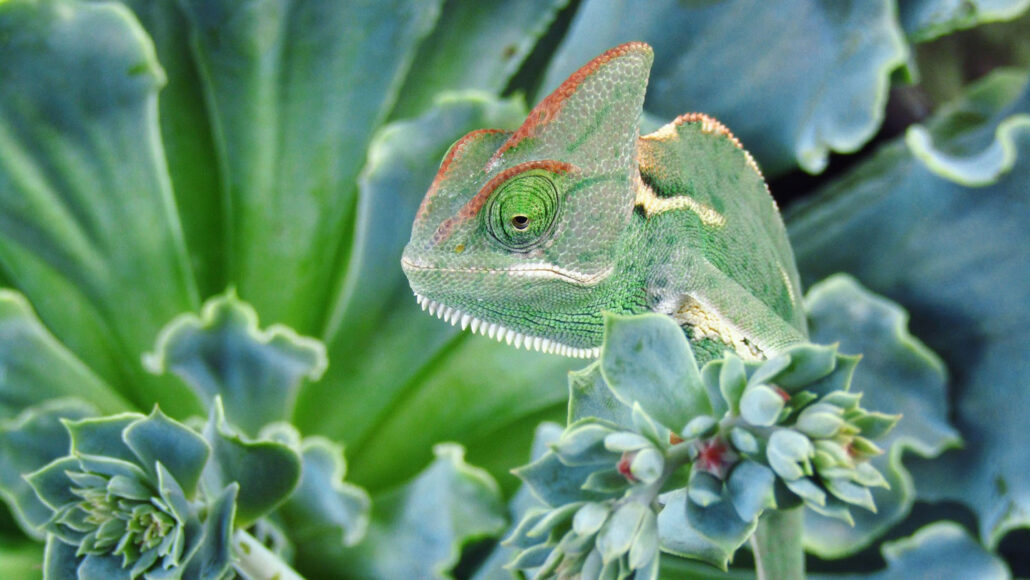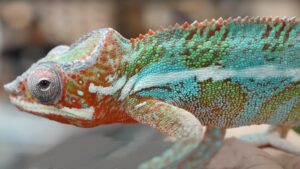Veiled chameleons typically reach a size of 14 to 18 inches in length. Females are generally smaller, averaging around 10 to 14 inches.
Veiled chameleons, known for their striking colors and impressive size, are a popular choice among reptile enthusiasts. This species, scientifically named Chamaeleo calyptratus, originates from the Arabian Peninsula and flourishes in a range of habitats. Their size makes them one of the larger chameleon species available for hobbyists.
As pets, they require a sizable habitat to accommodate their full-grown length. These arboreal reptiles are known for their distinct casque, a helmet-like ridge on their heads, which can grow as they age. Proper care and nutrition are vital for the veiled chameleon to reach its potential size, and with the right conditions, they can live up to 6 to 8 years, making them a long-term commitment for any reptile keeper.

Credit: www.livescience.com
The Fascinating World Of Veiled Chameleons
Welcome to the captivating world of Veiled Chameleons, a realm where these reptiles enchant spectators with their vibrant color changes and unique behaviors. Veiled Chameleons, with their impressive size and distinctive, towering casques, provide a window into the marvels of reptile adaptation and survival skills. Let’s dive into the details of their natural habitat, physical attributes, and the features that make them a standout species.
Native Habitat And Species Overview
Veiled Chameleons, also known as Yemen Chameleons, originate from the Arabian Peninsula. Specifically, they thrive in countries like Yemen and Saudi Arabia. Their typical environs include mountainous areas, valleys and plateaus where conditions are optimal for their survival.
- They prefer arid to semi-humid climates.
- These chameleons are arboreal, spending most of their lives in trees.
- They are territorial and often stay within a specific range.
Physical Characteristics And Unique Features
Vividly colored with a unique, protruding crest, Veiled Chameleons are truly a sight to behold. They are known for their striking physical features that set them apart from other reptiles.
| Veiled Chameleon Size | |
|---|---|
| Males | Up to 24 inches (61 cm) in length |
| Females | Generally shorter, up to 18 inches (46 cm) |
Their size varies with sex, where males typically grow larger than females. Peculiar to the Veiled Chameleon are their casques; helmet-like structures atop their heads. The casque serves multiple purposes:
- Helps channel water down to the chameleon’s mouth.
- Aids in temperature regulation.
- Enhances their impressive look.
Aside from the casque, Veiled Chameleons are famed for their color-changing abilities. This remarkable skill helps them communicate and adjust to temperature changes. Their prehensile tail, a gripping tool, allows them to skillfully navigate through branches. Meanwhile, their independently mobile eyes can rotate to almost any direction, giving them a wide field of vision. The combination of these characteristics makes the Veiled Chameleon not just big in size, but also huge in fascination.
Growth Chart: Hatchling To Adult
Welcome to the fascinating journey from hatchling to adult for veiled chameleons. These exuberant creatures go through an amazing transformation in size as they grow. Understandably, chameleon enthusiasts and potential pet owners are eager to learn about the growth stages of their scaly friends. Let’s dive into the growth chart that outlines the remarkable journey of veiled chameleons.
Typical Size At Birth
Veiled chameleon hatchlings are surprisingly small when they emerge from their eggs. Averaging a mere 3 to 4 inches in total length, they could comfortably sit on the tip of your finger!
Growth Milestones And Timelines
- First Month: Rapid growth begins.
- 2-4 Months: Steady growth continues.
- 5-8 Months: Sexual maturity approaches, growth spikes.
- 12 Months: Near adult size, up to 18 inches.
Each milestone in a veiled chameleon’s life is a step towards their full potential size. Within the first year, they can reach an impressive length almost ten times their birth size! Males typically become larger than females, with some males reaching up to 24 inches in total length. Females, on the other hand, may grow up to 18 inches.
| Age | Size Range |
|---|---|
| Birth | 3-4 inches |
| 1 Month | 5-6 inches |
| 3 Months | 7-10 inches |
| 6 Months | 10-15 inches |
| 12 Months (1 Year) | 13-18 inches |
Factors Influencing Size And Growth
Understanding the Factors Influencing Size and Growth of veiled chameleons offers fascinating insights into their lives. While size can vary, most veiled chameleons reach maturity within their first year. Factors such as genetics, diet, and environment play crucial roles in determining their growth.
Genetics And Individual Variability
Just like humans, genetic traits significantly impact the size potential of veiled chameleons. Individual variability means that size can differ even among siblings. Generally, males are larger than females, with males growing up to 24 inches and females reaching about half that size.
Diet And Nutrition Essentials
- A diet rich in calcium and vitamins supports healthy growth.
- Variety is key — a mix of insects such as crickets, mealworms, and roaches is essential.
- Regular feeding schedules help maintain consistent growth.
Environmental Impacts On Growth
The chameleon’s habitat plays a significant role in their development. The right balance of heat, humidity, and UVB lighting is critical for optimal growth.
| Environmental Factor | Impact on Growth |
|---|---|
| Temperature | Warmer temperatures promote better digestion and growth. |
| Humidity | Aids in hydration and skin shedding. |
| UVB Lighting | Essential for Vitamin D3 synthesis and calcium absorption. |

Credit: www.snexplores.org
Measuring Up: Male Vs. Female Veiled Chameleons
Understanding how big veiled chameleons get is essential for prospective pet owners. These unique reptiles exhibit significant size variations between the sexes. This guide helps you grasp the size and growth differences between male and female veiled chameleons.
Sexual Dimorphism In Veiled Chameleons
Veiled chameleons showcase sexual dimorphism, meaning males and females differ in size and appearance. The males generally possess longer bodies and more pronounced head crests, known as casques. These casques can grow quite tall, making them easy to spot.
- Males: Taller casques, vibrant colors
- Females: Smaller casques, subtler hues
Size Comparison And Breeding Implications
Male veiled chameleons can reach lengths up to 24 inches (61 cm), making them one of the larger chameleon species. Females are more petite, usually growing to about 12-14 inches (30-35 cm).
| Gender | Average Length |
|---|---|
| Male | Up to 24 inches |
| Female | 12-14 inches |
This size difference has breeding implications. Larger males often signal stronger genetics and can be more attractive to females. These sizes also indicate the space and habitat needs for each gender. An appropriate enclosure ensures a healthy and happy chameleon life.
Caring For Your Giant: Husbandry Practices
Veiled chameleons boast a grandeur that commands a tailored approach to their care. As their vibrant colors stretch across their impressively-sized bodies, enthusiasts must engage in dedicated husbandry practices. Ensuring these reptilian giants thrive involves more than just love. It requires a precise setup and vigilant health care.
Optimal Enclosure Setup For Growth
An ideal habitat is crucial for your veiled chameleon to reach its full size potential. Here’s a guide to create the perfect home:
- Spacious Terrarium: Minimum 24x24x48 inches for adults.
- Vertical Space: Ample height for climbing and exploration.
- Plants and Vines: Provide natural hiding spots and climbing opportunities.
- Temperature Gradient: A range from 72 to 80°F with a basking spot at 85 to 95°F.
- UVB Lighting: Essential for calcium metabolism and overall health.
- Humidity Levels: Maintain between 50-70% through misting and foggers.
- Water Source: Drip systems mimic natural rainfall for hydration.
Remember, bigger is better for these creatures who love to roam and grow.
Health Monitoring And Veterinary Care
Regular check-ups and at-home monitoring are key to catching health issues early. In particular, growth progression and any changes in behavior or appearance signal the need for further inspection. Follow these steps for a healthy chameleon:
- Monitor feeding habits and weight regularly.
- Look for signs of stress, like darkened colors or persistent hiding.
- Check for physical abnormalities: swelling, cuts, or bumps.
- Observe stool for consistency and frequency.
- Annual vet visits for professional health assessments.
A proactive approach to health can mean the difference between flourishing and merely surviving. Partner with a reptile-savvy vet for tailored health strategies.
Conservation Status: Preserving These Gentle Giants
Veiled chameleons are not just beautiful; they are an essential part of our ecosystem. These reptiles can reach impressive sizes with males up to 24 inches long and females around 18 inches. Their growth reflects their health and the state of their habitat. But, how do we ensure these gentle giants thrive for generations to come? Let’s explore their conservation status and how each of us can contribute to their preservation.
Current Conservation Efforts
Veiled chameleons face several threats, including habitat loss and the pet trade. Ethical and scientific measures are crucial for their survival. Conservation groups work tirelessly to sustain natural habitats and limit illegal trade. Governments impose strict regulations on chameleon export. Researchers monitor wild populations, ensuring they remain robust. Educational campaigns raise awareness about the species’ needs. It’s a collective effort aimed at ensuring a future for these reptiles.
- Protected areas: Establish and manage reserves
- Legal framework: Enforce laws against illegal trade
- Research: Study populations and habitats
- Awareness: Inform the public on conservation importance
How You Can Help Protect Veiled Chameleons
Protecting veiled chameleons is a job for everyone. By making conscious choices, you can have a direct impact. Choose pets sourced from ethical breeders. Support habitat preservation efforts. Educate others about the chameleons’ plight. Every small step contributes to the larger cause of conservation.
- Ethical pet ownership: Purchase from reputable sources
- Support conservation: Donate to conservation groups
- Educate: Share knowledge about chameleons and their needs

Credit: www.snexplores.org
Frequently Asked Questions Of How Big Do Veiled Chameleons Get
How Long Does It Take For A Veiled Chameleon To Reach Full Size?
A veiled chameleon typically reaches full size within 12 months.
How Big Of A Tank Does A Veiled Chameleon Need?
A veiled chameleon requires a minimum tank size of 36 inches tall, 24 inches long, and 24 inches wide. Larger enclosures are preferable to ensure ample space for climbing and proper ventilation.
Are Veiled Chameleon Good Pets?
Veiled chameleons can be good pets for experienced reptile owners. They require specific care, including proper habitat, humidity, and diet. Their unique behavior and appearance offer a rewarding experience for dedicated caretakers.
How Long Do Veiled Chameleons Live As Pets?
Veiled chameleons typically live between 5 to 8 years as pets with proper care and a suitable environment.
Conclusion
Veiled chameleons truly impress with their size, with males reaching up to 24 inches and females up to 14 inches. Caring for these creatures means accommodating their growth throughout their lifespan. By understanding their potential size, reptile enthusiasts can ensure these captivating pets thrive in suitable environments, contributing to their overall wellbeing and longevity.


